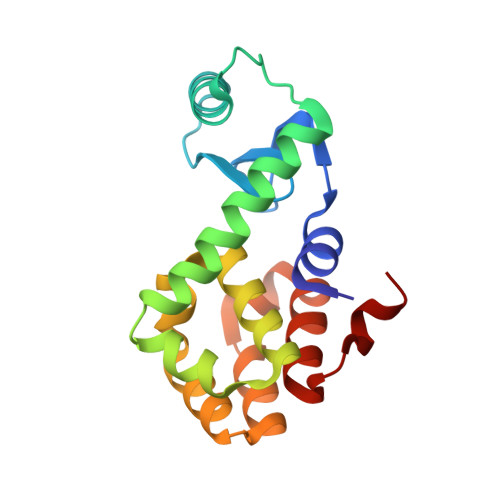Perturbation of Trp 138 in T4 lysozyme by mutations at Gln 105 used to correlate changes in structure, stability, solvation, and spectroscopic properties.
Pjura, P., McIntosh, L.P., Wozniak, J.A., Matthews, B.W.(1993) Proteins 15: 401-412
- PubMed: 8460110
- DOI: https://doi.org/10.1002/prot.340150407
- Primary Citation of Related Structures:
1L00, 1L98, 1L99 - PubMed Abstract:
In order to correlate between spectroscopic and structural changes in a protein, the environment of Trp 135 in T4 lysozyme was deliberately perturbed by the replacement of Gln 105 with alanine (Q105A), glycine (Q105G), and glutamic acid (Q105E). In wild-type lysozyme, Trp 135 is buried, but the indole nitrogen is hydrogen-bonded to the side-chain of Gln 105. In the Q105G and Q105A mutant structures, the indole nitrogen becomes accessible to solvent. Crystallographic analysis shows that the structures of all of the mutants are similar to wild-type. There are, however, distinct rearrangements of the local solvent structure in response to the new side-chains. There are also small but significant changes in the relative orientations of the two domains of the protein that appear to result from a series of small, concerted movements of side-chains adjacent to residue 105. Evaluation of the fluorescence and phosphorescence of the mutant proteins in terms of their observed three-dimensional structures shows that large spectral changes do not necessarily imply large changes in structure or in static solvent accessibility. Increases in polar relaxation about the excited state of tryptophan may be the result of only small increases in local dynamics or solvent exposure. 1H-NMR was also used to monitor the effects of the substitutions on Trp 138. In Q105E, but not in Q105G, Q105A and WT, the H epsilon chemical shift of Trp 138 is very pH-dependent, apparently reflecting the titration of Glu 105 which has a spectroscopically determined pKa of 6.0. The elevation of the pKa of Glu 105 in Q105E is also reflected in the pH dependence of the stability of this mutant.
Organizational Affiliation:
Institute of Molecular Biology, University of Oregon, Eugene 97403.



















